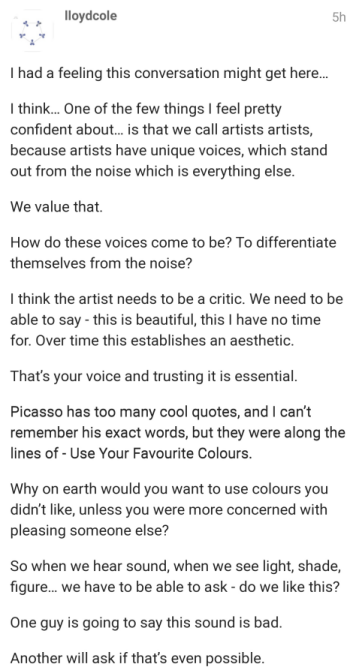Sonic Tapestries #23 is now available in the MixCloud archive. This is an episode of a radio show on London’s Resonance Extra which, this month, featured modular synth artists.
Roughly 11 and a half minutes in, they introduce my piece “and then gone” from Passing Through. Here’s what the guest, Simon Morgan, had to say:
This is someone I came across online, an American artist named Starthief who I think is really excellent, and embodies what I would consider the modern spirit of modular, which has got its roots in the early days, the Gong track you just played. And along with all the other artists and contributors and builders and designers in the scene is giving modular this rebirth. This is someone that I think makes really, really lovely sounds.
Thanks Simon! And the discussion afterward:
Mat Hart: That was really nice! It kind of progressed from sort of more ambient stylings to sort of more… sawtooth?
SM: It’s kind of got that edge to it in pieces, which I really like.
MH: One of the things that I listen more and more now to modular synth music is trying to discern what elements are analog and what elements are digital. And I feel personally quite lost in that minefield. I know you’ve got quite an impressive knowledge of both worlds, can you listen to that and sort of go ‘ah, that is that synth?’
SM: To some extent I think one can — and one can always slip on the banana skin of your own preconceptions as well when you’re doing that. Starthief is someone I’ve come across on one of the modular forums, so I happen to know a little bit about how he makes his music — I stress a little bit — and I know that he has some digital elements to what he does, and I think knowing that I can probably identify those where they show up in that track. And I think the analog/digital debate, which has many facets, is in some ways overstated. Given modern technology, personally I’m much more about results than tools. If something gives me the results I want, I’m not that bothered whether it’s analog or digital technology. I use both those worlds in my own music and am happy to do so. I believe Starthief — probably, not knowing him but knowing a little bit about how he works — probably would not be very far from that position. There’s some digital in there, yeah.
To address that last bit: a lot of agreement here. In the last three decades we’ve been through a few cycles where digital was king and analog was demonized, and vice-versa. In retrospect it all seems silly and kind of embarrassing. Analog and digital each have their strengths, and there’s no reason not to use them together.
I would characterize my system as mostly digital now, with a few key analog pieces — and of course the analog control paths and signal paths that define Eurorack. This particular piece is no exception — the sound source is the ER-301 Sound Computer, which is partially modeling an analog circuit. FM is from Kermit, a proudly lo-fi digital oscillator, but slower modulation is from Maths, a proudly analog modulation and signal-mixing tool.
Somewhat in this vein, here’s something recently posted on Lines in a thread debating “inscrutable” musical tools, which resonated with me:

My favorite colors happen to include both analog and digital. (And of course the bit about artist as critic very much hits home with me, as that’s what I finally realized in 2017.)
Anyway, Simon’s own piece in this show is lovely and as ghostly as its title suggests, and there are some other very highly regarded musicians featured as well. Suzanne Ciani, Richard Devine, Tangerine Dream… I’m kind of dizzy to have my music included among theirs, really. So maybe go have a listen. 🙂

